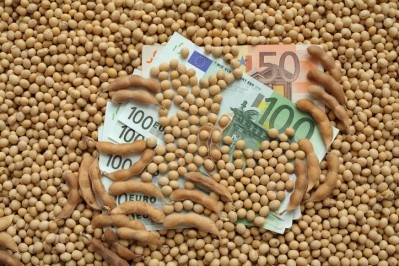USDA: Corn, soybeans set for production hike

The US Department of Agriculture (USDA) released details of anticipated use, production and exports for feed grains Wednesday [September 12] in its World Agricultural Supply and Demand Estimate report.
Overall, corn and soybean production is expected to increase for 2018/19 said Chad Hart, associate professor of economics, crop markets specialist and extension economist at Iowa State University. However, the increase in soybean production was slight below expectation while corn production exceeded predictions.
“The numbers turned out to be not as bad as trade was thinking they would be,” he told FeedNavigator. “As for corn and wheat, especially for corn, there was an expectation that the numbers would be smaller than what came out.”
“But in the grand scheme of things what came down, especially from a corn and bean perceptive was just massive crops and record yielding crops,” he added. “That was the big blow here it didn’t matter where you looked you just saw plenty of supply.”
However, there are several elements that still have to be considered regarding the corn production – including that quality could become an issue as harvest progresses, he said. Some regions, like the southern Iowa and Missouri crops, saw drought stress and then rain toward the end of the growing season.
“It may not pull yields down, but it could create some quality issues,” Hart said. “We could see more molds … we could worry about aflatoxin.”
Additionally, trade uncertainty and the potential for storm damage, like what could be seen from the impending landfall of Hurricane Florence also have to be considered, he said.
Corn considerations
US corn production in 2018/19 is expected to grow and see increased domestic and export use along with higher ending stocks, said the USDA.
Overall production is forecast to be 14.83bn bushels – an increase of 241m bushels from August estimates, said the department. Corn supplies also are expected to be higher as the larger crop offsets the drop in beginning stocks from strong exports in 2017/18.
Overall ending stocks are predicted to increase as supply outstrips use, the department said. Season-average corn prices were dropped by $0.10.
The corn yield numbers provided some surprise, said Hart. However, several states in the central part of the Corn Belt are all predicting record yields.
“For the 2017/18 crop we saw incredibly strong exports for that corn crop and projections are nearly as strong,” he said, adding that the large crop also has some positives for feed producers and users.
“That’s the deal for the livestock industry folks and for the pork guys this was good news,” he said. “It does mean that feed remains inexpensive, and this helps some of the blow that the pork industry has seen from trade disputes.”
Globally corn production is expected to increase based on production in the EU, Angola, Paraguay, Turkey and Serbia, which offset declines in Canada, South Africa and Guatemala, said the USDA.
Corn exports in 2018/19 are anticipated to increase for Serbia, Ukraine and Paraguay, but drop for Canada and South Africa, the department said. Several countries including the EU, Japan, Guatemala and Brazil are expected to have larger imports of the feed grain.
Exports in 2017/18 were lowered for both Brazil and Argentina based on slower trade than anticipated, the department reported.
Global ending stocks for 2018/19 were reduced from previous estimates, the department said. However, overall global corn stocks were raised.
Soybeans and oilseeds
Total oilseed production in the US for 2018/19 is expected to increase with production reaching 138.4m tons – up 2.9, from August estimates, said the USDA. The bump is primarily based on increased soybean and cottonseed production.
Soybean production is expected to have a record 4.69bn bushels – up 107m bushels – and with a record yield of 52.8 bushels an acre, the department said. Soybean supplies and ending stocks also were raised.
Soybean crush predictions were increased by 10m bushels, the department said. Season average price was dropped to a range of $7.35 to $9.85 a bushel and meal prices fell to a range of $290 to $330 per short ton.
Soybeans are expected to have a strong export number in 2018/19 although down slightly from previous forecasts, said Hart. “The wild card here is USDA numbers show a smaller drop than the Chinese official estimates,” he added.
“We did see a little more on the domestic demand side for soy and we saw the crush go higher,” he said. “But the big wildcard here is the exports – the dispute with China looms large because of the side of that market.”
Additionally, the African Swine Fever virus outbreak in China and what it means for pork production is still developing, he said.
“We know that the Chinese hog industry is having to adjust,” he said. “As that outbreak looks to be on the increase, how big does it have to get before it pulls down on the need for China’s feed? That’s a wildcard because the soybeans were to fill that pork feed need.”
The US had higher exports and crush in 2017/18 along with smaller ending stocks than initially expected, the USDA reported. Soybean exports were increased 20m bushels to 2.13bn based on trade data, and crush was raised by 15m bushels.
Globally the oilseed prediction for 2018/19 anticipates increased production, a drop in trade and larger stocks, the department said. Again, soybeans and cottonseed are attributed to the increase.
Soybean production was up 2.2m tons based on production bumps in China and the US only partially offset by a drop in growth for Canada, India and Uruguay, the department said.
International exports in 2018/19 are forecast to drop by 1.1m tons, based on reduced exports from Canada and Uruguay, the department said. China’s soybean imports are also predicted to fall as protein meal demand growth slows along with crush.
However, Egypt and Iran are expected to see an uptick in imports of soybeans, the department said.
Global ending stocks in 2018/19 have been raised based on the US and Argentina, and only partially offset by a drop in stocks for Brazil, they said.
Wheat and barley expectations
The expected season-average farm price was narrowed to $4.70-$5.50, the USDA said.
Globally, wheat supplies for 2018/19 were increased by 4.7m tons based on a production bump and higher beginning stocks, the department said. Production is expected to increase for Russia, Kazakhstan and India, which should offset a dry weather-based drop for both Australia and Canada.
Exports on the global level are forecast to be down 2.5m tons predominately from Australia and Canada owing to smaller crops, the department said. Imports for Indonesia and Iran also are predicted to be down.
However, use is set to increase by 2.3m tons based on feed use in Russia and the EU, the department said. Ending stocks are expected to grow, but remain lower than the previous year.
World barley production was reduced based on drops from the EU, Australia and Ukraine, the department said.











